The Gigabyte P35X v3 Review: Slim GTX980M Gaming Laptop
by Brett Howse on April 23, 2015 8:00 AM ESTDisplay
The P35X is offered with a 1920x1080 resolution as standard, and the optional upgrade is a 2880x1620 Panasonic unit, which is what is installed in this review unit. As an IPS display, it offers great viewing angles, and the 8 bit color and full RGB stripe help with color. Gigabyte has gone with an anti-glare coating on this device, which seems to be popular in this segment.
In the above image, you can clearly see the anti-glare coating which gives a bit of a muddied look to the individual pixels. At 194 pixels per inch (PPI), the P35X offers a great compromise between the really high PPI devices like the Razer Blade, and the 141 PPI of the 1080p panel offered in the base model. As a gaming system, being able to run games at the native resolution of the panel is certainly a good thing. On the desktop, Windows automatically chooses 200% scaling for this panel, but it is pretty easy to use it at 150% as well. Those with even better eyes can likely go as low as 125%, opening up quite a bit of desktop real estate.
To measure the output of the display, we turn to SpectralCal’s CalMAN 5 software with a custom workflow, and to measure brightness and contrast ratios, the X-Rite i1Display Pro colorimeter is used. Testing color accuracy of the display is done with the X-Rite i1Pro spectrophotometer. As with our battery life testing, we do our testing at 200 cd/m².
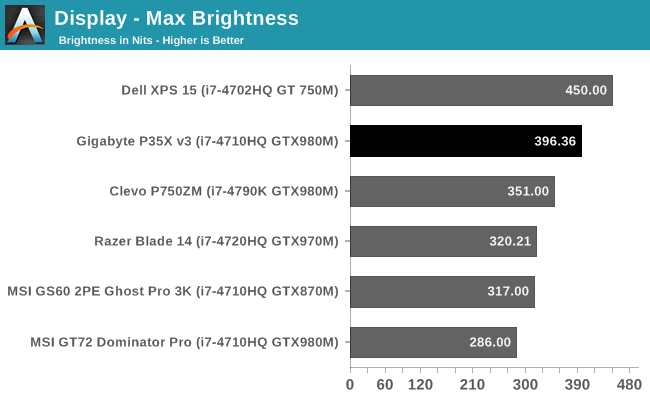
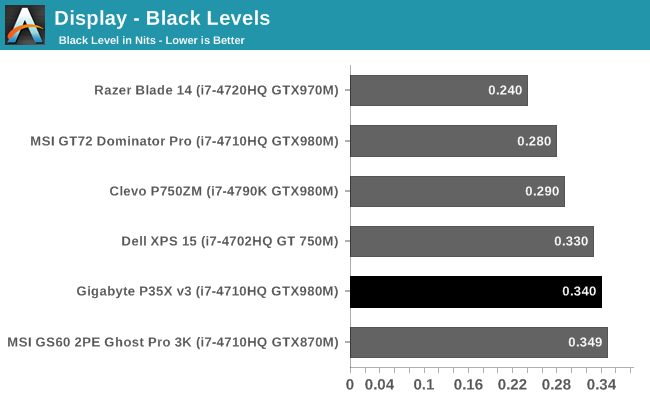
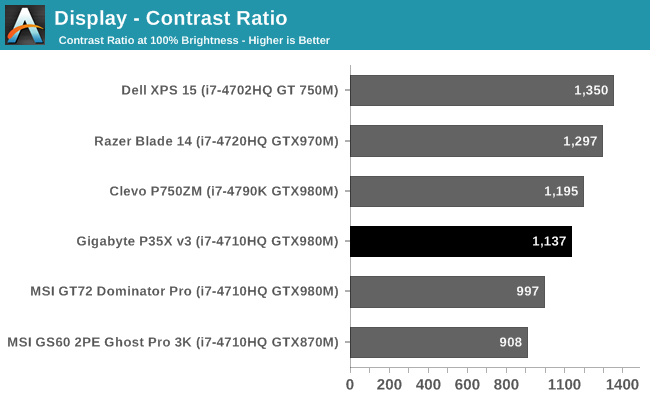
Brightness of the P35X is excellent, coming in at almost 400 nits. With the combination of such a bright display and the anti-glare coating, there is almost no scenario where you will struggle seeing the display. Black levels are not class leading, but overall contrast ratio is still a very respectable 1137:1.
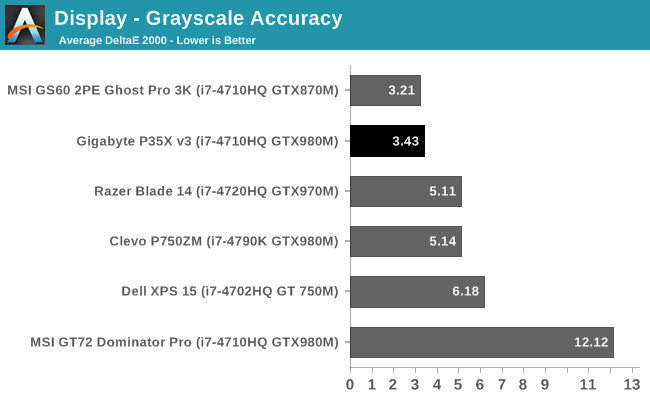
Grayscale is also quite good out of the box, with the P35X just over the ideal target of 3.0. There are only a handful of devices which have outscored it out of the box.
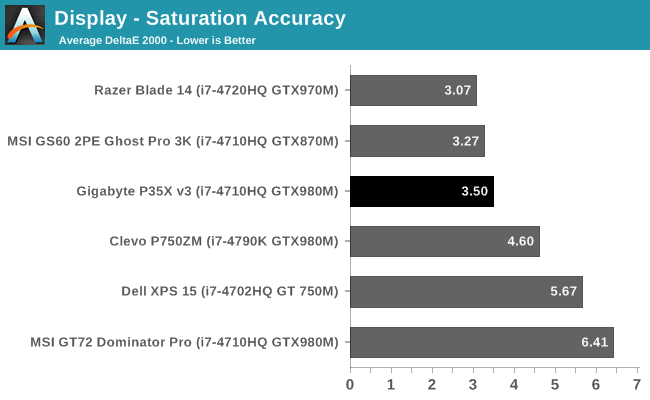
Saturations are also quite good out of the box, but blue and magenta is oversaturated when targeting the sRGB colorspace. At 100% saturation, all of the colors except cyan and yellow are close to dE of 6. So even though the overall average is quite good, it is not perfect or linear in the error levels.
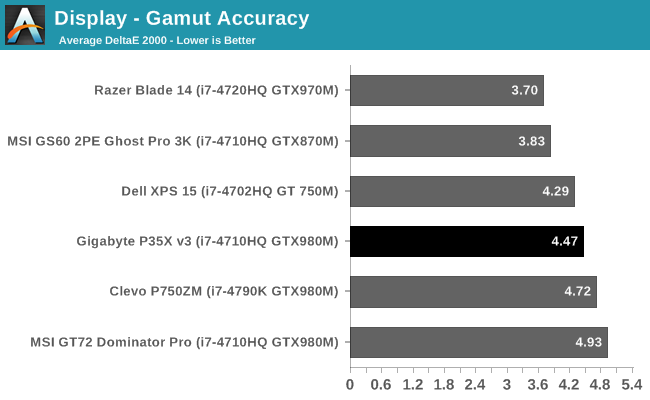
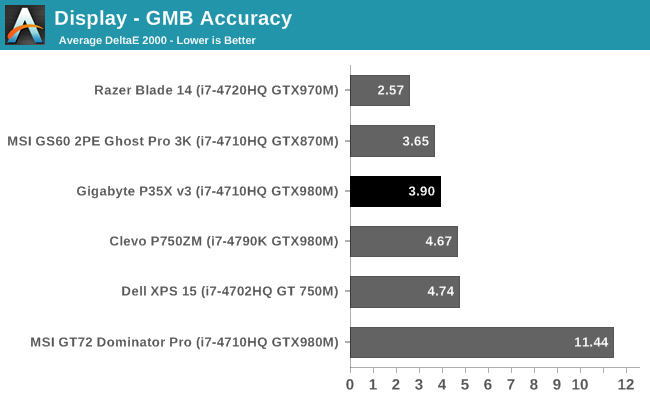
Gretag MacBeth is a more comprehensive test, and the dE falls to almost 4. Still, for an uncalibrated result, the P35X is one of the more accurate displays we have seen, although it is still some ways off the most accurate ones such as the Razer Blade’s IGZO panel.
Calibrated
Calibration really helps out on the grayscale results, bringing them under 1.0, and a smaller boost is seen in all of the other scores as well.
The Panasonic display in the P35X is very good, and out of the box scores are of the sort that most people will be perfectly fine with it. It is a full 8-bit panel, and has good color reproduction out of the box. The resolution is great too, with sharp text and images, but as a gaming system I think the compromise of high resolution versus gaming performance should favor gaming performance, and the P35X has delivered here.



















55 Comments
View All Comments
xilience - Thursday, April 23, 2015 - link
Any thoughts for why there is such a large difference in FPS in GRID:Autosport versus the Clevo?SpaceRanger - Thursday, April 23, 2015 - link
From the looks of it.. The Clevo is sporting a true 4790k(84w), while the Gigabyte's using a 4710HQ(47w) CPU. Apples and Oranges comparison in my eyes.nerd1 - Thursday, April 23, 2015 - link
It's as slow as razer blade with 970M - which means the whole system throttles a lot under pressure, even compared to razer blade (which is not well known for great cooling)Brett Howse - Thursday, April 23, 2015 - link
That's not what it means at all. It means that GRID Autosport is more CPU bound. The Clevo with the desktop CPU is way ahead. Razer has a faster CPU and slower GPU, but it's still behind.xKrNMBoYx - Friday, April 24, 2015 - link
Okay so some of the benchmarks include the MSI GT72 Dominator Pro with basically the same CPU and GPU. Yet all those benchmarks show the P35X beating the GT72 even though they are similar. So if a thin P35X can beat a more roomy GT72 with better cooling how is the P35X suffering from throttling issues?The next thing to come to mind logically would be the comparison of the CPUs as the Clevo is using a full 4790K that can run all cores on 4GHz and then the 4720HQ (Razerblade) which is better than the 4710HQ (P34X). Every benchmark here shows the 980M in the P35X beating the 970M by at least ~10FPS and you look at one benchmark where the difference is less than 10FPS and say they perform the same?
Frumious1 - Friday, April 24, 2015 - link
Different drivers would be the reason. GT72 was tested when GTX 980M was practically brand new. NVIDIA had several driver updates that provided substantial increases to performance since last October/November. Too bad AnandTech can't go back and retest some of their previous laptops and update performance with the latest drivers.xKrNMBoYx - Monday, April 27, 2015 - link
You're right. I was hoping/expecting they did those tests over again. The lastest driver update did boost the desktop Maxwell GPU performances. Seeing that I do have a GT72 Pro with a 980M I should be able to try running a few of these game benchmarks to see if I get similar numbers.nerd1 - Thursday, April 23, 2015 - link
This review looks extremely shallow - it almost skipped over its main concern (thermal). A single 3D game for thermal testing? Seriously? Since when Anandtech review became like this?hfm - Thursday, April 23, 2015 - link
At least the system cooling solution noise was mentioned, which sounds like a deal-breaker in my eyes.nerd1 - Thursday, April 23, 2015 - link
Games rarely utilize CPU at all, and many games do not push GPU either. Most other hardware sites uses synthetic tests designed to really push the hardware, and then tests a number of demanding games too.And face it, you cannot cram x80M GPU and quadcore CPU inside 20mm thin body and expect it to run cool and silent. Even 17 inch gaming rigs sometimes throttle.